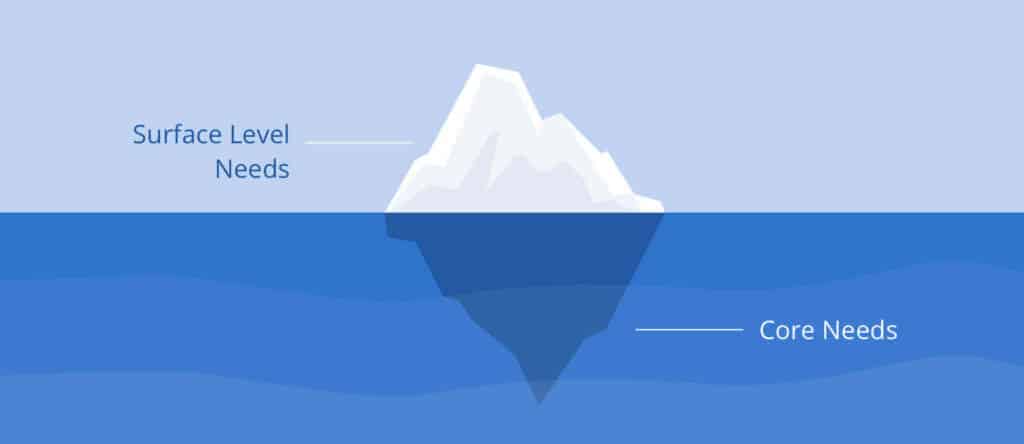
Needs-Based Selling Guide to Success
A poll of B2B sales leaders on their top sales challenges found that the most prevalent problem was with engagement. That shouldn’t be a surprise, as the global marketplace continues to endure rapid changes from new technological developments, supply-chain and economic disruptions and increased competition. Not only is the sales process becoming increasingly complex, your sales professionals have to compete against more products and services — some of which aim to be the next big industry disruptors.
How can your sales professionals effectively compete against such a wide field, especially when some of which are completely unknown? One approach is that they shouldn’t be focused on selling a product or service but instead on providing solutions to meet your customer’s most important needs.
Needs-based selling is a process that allows sales professionals to connect more with a customer’s core needs, some of which evolve and change over time. When your sales professionals understand how to find these needs, they’re better able to assist clients in overcoming challenges and meeting their goals — which will help build relationships with clients, win their loyalty and make selling easier.
What Is Needs-Based Selling?
Benefits of Needs-Based Selling
Implementing a Needs-Based Selling Strategy
Needs-Based Selling Tips
Putting Needs-Based Selling into Practice
What Is Needs-Based Selling?
Needs-based selling, sometimes called consultative selling, is the process of engaging with a customer to understand their essential challenges, larger goals and fundamental needs. This approach attempts to go beyond the most immediate, most urgent needs to determine the fundamental issues that may be causing or exacerbating those surface problems.
Think about a hypothetical situation of a client who doesn’t have enough water to drink. You could sell them some bottled water, or you could dig a little deeper to determine what’s causing problems with their well. The first approach would bring a short-term solution and immediate profits. Alternatively, offering them a service that fixes their well would not only build a stronger relationship by serving their core need, it would also make them more likely to consider you first for another service in the future.
One way we illustrate this concept of getting below the surface level is the iceberg metaphor. At the top of the iceberg, above the waterline, we experience mostly technical-related issues and immediate needs. They’re the easiest to see and often can be the most pressing.
However, focusing on those needs that exist above the waterline misses the largest part of the iceberg — which, if you happen to know a little about how the Titanic sank — is where the real problems are. Deep under the waterline are bigger problems that are harder to uncover and require more in-depth and longer term solutions.
Determining these core needs requires asking questions that go beyond “what do you need” or “how can we help you?” Your sales professionals need to act more like independent consultants; they’ve been hired to examine a problem or difficult situation and determine what changes need to be implemented. Their challenge, after coming to consensus about those problems, is to then position your products or services in a way that addresses those core needs.
Needs-based selling stands in contrast to transactional selling, where a sales professional is more focused on connecting the customer to specific solutions — regardless of what their larger issues are. In this approach, the sales professional is committed to “selling” the benefits of their product and explaining how those benefits can help the customer.
Need-based selling is similar to solution selling in that both focus on building a relationship with the customer or prospect. However, the emphasis is different as solution selling is solution-focused and is more intent on achieving specific outcomes, whereas needs-based selling is more customer-focused by looking for ways to address their needs.
Needs-based selling also shares some similarities with relationship selling, though that technique focuses much more on building personal connections rather than determining needs.
Selling Strategies Comparison Chart
| Focus | Strengths | Cons | |
| Needs-based selling | Addressing a client’s fundamental needs | Builds trust, forms strong client relationships, generates insights into a client’s needs, goals and challenges, offers long-term solutions | Time-consuming, requires strong conversation skills and critical thinking |
| Solution selling | Finding the right solution for a client’s challenges | Forms strong client relationships, generates insights into a client’s needs, concentrates on generated value and benefits | Time-consuming, requires strong product knowledge and conversational skills, questions can seem leading |
| Relationship selling | Building a strong connection with a client | Builds trust, forms strong client relationships | Time-consuming, requires strong conversational skills, constant outreach, less tied to products/services |
| Transactional / Product selling |
Selling the benefits of a product or service | Product-focused, concentrates on generated value and benefits | More focused on short-term solutions, doesn’t build strong relationships, can seem pushy |
Benefits of Needs-Based Selling
The chief argument for adopting a needs-based selling strategy is that it is especially suited to today’s customers’ more nuanced needs. Rather than attempting to sell a product’s benefits and position it against a field of competitors, needs-based selling has the advantage of providing the sales professional with more detailed information about the client for a targeted approach. This provides a few benefits:
- An understanding of a client’s larger needs informs the sales professional about what would be the most relevant aspects of a product or service. This allows them to better position their services to provide long-term benefits, which can be a more reliable source of revenue.
- Gained insights can provide more information about cross or upsell opportunities. Even if there’s no immediate solution to a client’s larger needs, the sales professional could uncover related issues that may be served by other solutions provided by their company. They may also discover needs that are more likely to surface later in the sales cycle.
- Talking to a customer as more of an advisor allows the sales professional the chance to rise to the level of someone that the customer trusts and will actively seek out. This type of relationship is more likely to be long-lasting, and therefore more profitable in the long-term.
- Addressing a customer’s needs instead of extolling the virtues of a product helps to avoid the perception of “hard selling,” which can turn some customers off. Every prospective customer knows that a sales professional is attempting to make a sale — but do they have the customer’s best interest in mind, or their own? Needs-based selling helps make the case that it’s the former.
Implementing a Needs-Based Selling Strategy
Adopting a needs-based strategy is an entire mindset. A sales professional has to be genuinely curious about their customer, their needs and how they could collaborate on finding solutions. The needs-based sales professional puts customers first and attempts to discover core needs by asking open-ended questions about their objectives and challenges.
To start, it’s imperative that the sales professional develop a wide foundation of knowledge about the customer. The sales professional has to research all aspects of the customer’s business, including its history, before having any conversations. This will provide background information on existing, consistent and recurring problems, as well as any previous solutions the customer may have tried.
Understanding the larger context will help the sales professional direct their questions. In discussing issues with the client, the questions should always be open-ended and framed in a way to lead to additional, relevant questions. Example needs-based selling questions include:
- What is your company trying to achieve in the short-term?
- What are your long-term goals? Where do you want to be?
- What’s holding you back from achieving those goals?
- Can you elaborate on your current problem?
- How long have you been dealing with this problem?
- What other solutions have you tried to solve it?
- What do you believe is the root cause of the problem?
- Where is your production experiencing the most problems?
- Besides this, are there any other problems that you are facing?
Needs-Based Selling Tips
The most important aspect of the needs-based selling strategy to remember is that it isn’t a presentation or an interrogation — it’s a dialogue. Aside from knowing the types of questions to ask, here are some recommendations for sales professionals in how they should approach the conversation, how to prepare and how to follow up.
- Don’t dominate the conversation. You’ll need to ask questions at the right time and know when to listen — the idea is to avoid talking at the customer. While knowing what questions to ask is important, don’t rely on a pre-set list. Instead, use active listening skills to process any relevant information, and then follow-up with insightful questions framed in a way to provide the answers you’re looking for. This does require strong conversational and interpersonal skills, as you’ll need to be agile and quick to adapt — knowing when to ask questions, when to follow different threads and when to offer solutions.
- Offer a summary of insights. Whenever there’s a moment of understanding and you’ve identified a core need, summarize your understanding of it — from its root causes to current challenges and possible solutions. This not only helps you confirm the important details, it may help to jog the customer’s memory about any related issues that they’ve overlooked. This technique also shows that you’re paying close attention and are actively working through their concerns.
- Employ the right technology tools. Your efforts can be much easier if you make use of a customer relationship management (CRM) system to systematically manage all the relevant customer data. Be sure to log and record all interactions — from calls and emails to face-to-face conversations — and note all essential details in the CRM. According to Hubspot, 54% of sales leaders say CRM usage is one of the most important productivity metrics — more than usage of sales tools, conversations or emails sent — and it is the most prevalent productivity metric used by sales leaders.
- Offer the right solutions. Once you know what the prospect wants and what the important needs are, offer solutions that you genuinely believe will help them. Ideally, the sales professional will show how your company’s product can help in achieving the customer’s goals, but they shouldn’t shy away from offering solutions or leads that don’t directly involve your company. That may seem counterintuitive, but that honesty and professionalism goes a long way toward building trust and strengthening client relationships. Plus, the sales professional can always follow up later with additional details on the benefits clients will experience by using your product or service.
Putting Needs-Based Selling into Practice
According to a McKinsey study, top-performing sellers excel at understanding customer needs, delivering on the value proposition and negotiating and closing deals — which are skills that “go above and beyond the best practices of transactional sellers and require active training of the sales force.”
Here at Global Partners Training, this approach has been core to our mission for more than three decades. As pioneers in the art and science of building mutually profitable customer relationships, we are continuously improving our innovative, industry-leading sales and service training programs to help enterprise companies connect with their customers and build stronger relationships that create greater value.
If you’re interested in how our high-value sales training can empower your sales professionals to more confidently identify and connect with your customers’ needs, contact us to learn more.


